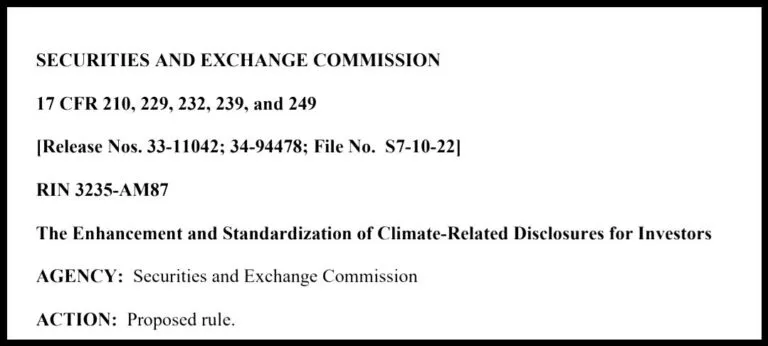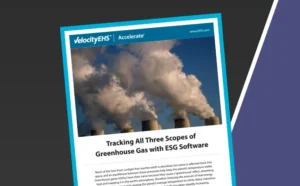The International Sustainability Standards Board (ISSB), created in late 2021 to improve the global consistency of ESG reporting, has published its first two draft standards for public comment. One standard lays out a framework for general sustainability-related disclosures, while the other standard specifically addresses climate-related disclosures. Both standards are sure to attract a great deal of interest and feedback from stakeholders in industry and in the financial sector who’ve been hoping and asking for more standardization of ESG disclosures.
In what follows, we’ll review the background of the formation of the ISSB and the contents of its first two draft standards, and provide some key takeaways about the future of ESG reporting.
The Background on ESG Reporting
While ESG is not new, it’s gained considerable momentum over the last couple of years because of a growing body of evidence linking higher ESG performance to better financial performance. For example, a 2020 Harvard study found ESG performance to correlate with economic value added (EVA) margin, which is the incremental difference in the rate of return (RoR) over a company’s cost of capital. In other words, companies with higher levels of ESG maturity see a better return on their investments than companies with lower ESG maturity.
The same 2020 Harvard study mentioned above also found that companies with the highest level of ESG performance had the lowest amount of volatility in business performance. For example, these ESG-mature companies were the least likely to endure a catastrophic event leading to a significant drop in the company’s share price. Because of evidence like this, financial institutions and venture capitalists increasingly use ESG performance as a lens through which to screen potential investments for risks that traditional financial disclosures might not identify.
Emergence of Multiple ESG Reporting Frameworks
With increased focus on ESG has come increased emphasis on ESG reporting. The downside is that there has been a proliferation of different reporting frameworks, most of which are voluntary but some of which are mandatory. Some, like the Task Force for Climate-related Disclosures (TCFD), are both in different contexts and regulatory jurisdictions. For example, New Zealand passed a 2021 bill (see screen capture below) that made them the first country to codify mandatory TCFD reporting. Meanwhile, other frameworks like the Global Reporting Initiative (GRI), the CDP (formerly the Carbon Disclosure Project) and SASB remain in common use, leaving organizations wishing to pursue ESG goals unsure of which framework to use.

Understandably, companies, financial institutions and public stakeholders have started asking for a more streamlined ESG reporting framework, to improve their ability to monitor and opportunities. There was growing demand for a global consensus, preferably one that wouldn’t “reinvent the wheel” but would building upon existing reporting frameworks to provide consistent standards for organizations around the globe interested in pursuing ESG.
The Formation of the ISSB
The International Financial Reporting Standards (IFRS) Foundation® addressed the growing demands for consolidated reporting framework by forming the International Sustainability Standards Board (ISSB) on November 3, 2021 at the COP26 event in Glasgow, Scotland. The IFRS’s financial accounting standards are currently accepted in 140 countries, so the Foundation has a good vantage point from which to build upon and consolidate ESG reporting frameworks.
The ISSB has received early support from a wide variety of global organizations, including the G7 Finance Ministers and the International Organization of Securities Commissions (IOSCO). The United Kingdom (UK) government has also stated its intent to incorporate the ISSB’s standards into its proposed Sustainability Disclosure Requirements (SDR). The UK government mentions that the SDR will be central to its approach to ESG in its policy paper Greening Finance: A Roadmap to Sustainable Investing.
To help establish and support the new Board, the Trustees of the IFRS created the Technical Readiness Working Group (TRWG), which consists of organizations with expertise in sustainability and integrated reporting standard-setting tailored toward investor expectations. According to the IFRS, the purpose of the TRWG is to give the ISSB “a running start, enabling it to respond to investors’ urgent demands for improved transparency and consistency in company reporting on sustainability matters.” The members of the TRWG are the Climate Disclosure Standards Board (CDSB), the International Accounting Standards Board (IASB), the TCFD, the Value Reporting Foundation (VRF—which brought together the Integrated Reporting Framework and SASB Standards) and the World Economic Forum (WEF).
The ISSB’s page announces their intention is “to deliver a comprehensive global baseline of sustainability-related disclosure standards that provide investors and other capital market participants with information about companies’ sustainability-related risks and opportunities to help them make informed decisions.” ISSB’s planned standards will cover important ESG topics, including climate risks, due to increasing demand from international investors. The ISSB plans to build upon existing general standards such as those issued by SASB, while also developing industry-specific standards.
ISSB’s Draft ESG Standards
We’ve now received our first look at ISSB’s work, in the form of two “exposure draft” standards the Board released on March 31, 2022:
- IFRS S1 – General Requirements for Disclosure of Sustainability-related Financial Information (the General Requirements Standard)
- IFRS S2 – Climate-related Disclosures (the Climate Standard)
Let’s take a closer look at each of these draft standards.
IFRS S1 (“General Requirements Standard”)
The “Objectives” section of this standard states that its purpose is to “require an entity to disclose information about its significant sustainability-related risks and opportunities that is useful to the primary users of general-purpose financial reporting when they assess enterprise value and decide whether to provide resources to the entity.” In other words, the standard aims to prompt companies to disclose ESG information accurate and relevant enough to provide a good window into their risks and long-term health, and help investors make informed decisions regarding the company.
Here’s a synopsis of key aspects of IFRS S1:
- Materiality: The assessment of materiality is made based on the sustainability-related financial information necessary for users of general purpose financial reporting (e.g., investors) to assess enterprise value.
- Core Content and Structure: proposes requiring the disclosure of sustainability-related risks and opportunities centered around four pillars: (i) governance; (ii) strategy; (iii) risk management; and (iv) metrics and targets. Specifically, a company would have to disclose:
- a description of significant sustainability-related risks and opportunities and the time horizon over which each could reasonably be expected to affect its business model, strategy and cash flows, its access to finance and its cost of capital, over the short, medium or long term; and
- how it defines short, medium and long term and how these definitions are linked to the entity’s strategic planning horizons and capital allocation plans
IFRS S2 (“Climate Standard”)
ISSB’s stated objective for this standard is to establish a framework for companies to disclose information about its exposure to significant climate-related risks and opportunities. Some of the information IFRS S2 would have companies disclose includes:
- information about the management and governance processes they use to monitor and manage climate-related issues and opportunities across their operations, including which body (e.g., the board or a committee) has oversight of these issues.
- information on how their business model, strategy, and cash flows could be impacted by physical and transition climate risks, such as flood damage or reputational damage based on carbon intensive product lines that may limit their ability to access financing.
- plans or targets related to climate issues, alongside detailed information in relation to how these plans will be resourced, and how the company will review progress against these targets over time.
- use climate-related scenario analysis to assess its risks and opportunities unless “unable to,” with a recommendation to use a scenario that aligns with the Paris Agreement (or subsequently revised international climate change agreements).
- Companies would be required to disclose their absolute Scopes 1 (direct emissions from operations), 2 (from energy use), and 3 (from their broader value chain) greenhouse gas (GHG) emissions, as well as the intensity of those emissions per unit of economic or physical output, and calculation of emissions would be required to be conducted in accordance with the relevant standards of the GHG Protocol
- The amount and percentage of a company’s assets or business vulnerable to climate or transition risks, and the percentage of executive compensation linked to climate-related considerations
These new draft standards fulfill expectations of multiple stakeholders for a greater consensus on ESG disclosures that could provide better data to inform business and financial decisions.
As Emmanuel Faber, Chair of the ISSB, said:
“Rarely do governments, policymakers and the private sector align behind a common cause. However, all agree on the importance of high-quality, globally comparable sustainability information for the capital markets. These proposals define what information to disclose, and where and how to disclose it. Now is the time to get involved and comment on the proposals.”
Next Steps for ISSB’s Draft Standards
The exposure drafts of the General Requirement Standard and Climate Standard will be open for public comment until July 29, 2022. We don’t know how long it will take ISSB to sort through that feedback and incorporate it into final standards, but the Board hopes to complete both of these standards by the end of 2022.
What happens once ISSB finalizes the standards? The standards do not themselves create new regulatory obligations, and organizations will mostly choose to follow them (or not) as they see fit. However, the ISSB is working closely with other international organizations and jurisdictions to support the inclusion of the global baseline into jurisdictional requirements, so as we’ve seen in the case of New Zealand and its rulemaking to adopt mandatory TCFD disclosures, it’s possible that some regulatory agencies may eventually undertake rulemakings to incorporate the ISSB standards regulatory requirements for disclosures.
Additionally, even if the finalized standards don’t wind up affecting your regulatory obligations, they will certainly affect the expectations of stakeholders, including potential investors and supply chain partners. As we’ve discussed here, ESG is gaining importance, and isn’t likely to go away anytime soon as a way for corporate leaders to organize their business plans and a way for investors to screen against otherwise hidden risks and for greater potential for returns on capital. That means you’ll potentially lose partners and opportunities for growth if you assume ESG is just a “nice-to-have” for other companies, lacking real impact on your business.
Introducing ESG QuickTakes: A Sustainability E-Newsletter!
Master ESG with our NEW quarterly publication. Get expert insights on regulations, energy management, and sustainability delivered straight to your inbox.
The Big Takeaways on Consolidation of ESG Reporting Frameworks
There’s a lot of information in ISSB’s two published exposure drafts. Let’s take a moment to distill a few key takeaways.
- While ISSB is definitely prioritizing disclosure of climate risks, the proposed standards address wider ESG responsibilities, as well. Companies that would follow the ISSB standards would need to report on a broad spectrum of ESG issues rather than just climate-related risks and opportunities.
- Companies following the ISSB standards would disclose their ESG metrics on their regular financial statements. This demonstrates that in the eyes of ISSB, ESG plays an important role in company financial performance, and ESG metrics therefore have a place on financial statements alongside other key information documenting and predicting financial health. This perspective dovetails with that seen in other recent standards and regulations in the ESG world. For example, in the US, Security and Exchange Commission (SEC) recently published a proposed rule (see screen capture below) that would require public companies registered with the SEC to disclose ESG data such as Scopes 1,2, and 3 GHG emissions on their regular report filings, such as on Form 10-K.
- ISSB’s proposed standards, and even the existence of the ISSB itself, reflect both the growing realization of the importance of ESG to businesses and their investors, and the need for streamlining and consolidating the growing number of reporting frameworks. This is an indication that industry is collectively “saddling in” for using ESG as an important lens for assessing business strategy and impact for the long haul. And that means, in turn, that any business ignores ESG at its own peril, because by doing so, they’re putting themselves at odds with the expectations of potential investors and supply chain partners, and limiting their business’s potential for future growth.
- Since ESG metrics, especially those tracking climate risks, are becoming increasingly central to business reporting frameworks, businesses hoping to establish and maintain ESG maturity need to start tracking those metrics now. Of course, the challenge is that many companies don’t have efficient processes for capturing and tracking data on all three scopes of GHG emissions, particularly Scope 3 sources like waste treatment facilities not under the organization’s direct control. Modern Climate software can help these organizations track all of their GHG emissions across all three scopes in a single platform, with simplified calculation and reporting capabilities.
In short, ESG is here to stay. Business leaders and EHS professionals are best advised to begin assessing the ESG issues material to their business, and finding ways to better manage their data collection and reporting.
Additional Information on ESG Management
If you’re looking for more information on ESG, we’ve got you covered.
To learn why ESG isn’t just something for big companies to be thinking about, check out our blog, “Five Amazing Benefits of ESG for Companies of Any Size.”
If you need more information on how to track all three scopes of GHG emissions, download our guide, “Tracking All Three Scopes of Greenhouse Gas with ESG Software.”

Our on-demand webinar, “ESG – What You Need to Know Now” provides a broad overview of what ESG is and how businesses can successfully navigate the journey from traditional EHS management to ESG maturity. A good companion piece to that is our blog, “Have You Mastered the ESG Pyramid?” which lays out why ESG builds upon and depends upon a solid foundation of good EHS management.
Finally, please be sure to follow us on Linkedin so you can keep up with more updates about the worlds of EHS and ESG, and the ways we can help you become safer and more sustainable.
Let VelocityEHS Help!
VelocityEHS Climate is just the tool you need to improve your energy management and your tracking of GHG emissions. Powerful utility data integration capabilities ensure you’ll be able to capture all your energy data, easily convert it to the units you need, and identify trends in energy usage. We also provide a single platform for tracking all three scopes of GHG emissions, with reporting capabilities aligned with major ESG disclosure frameworks.
ESG is here to stay, so get the tools you need in place today to achieve and maintain ESG maturity. Request a demo or contact us today to learn more about how we can support your continuing ESG journey.
